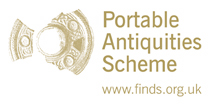File:Early-medieval strap end, Strap end (FindID 608567).jpg

Original file (1,281 × 1,426 pixels, file size: 216 KB, MIME type: image/jpeg)
Captions
Captions
Summary
[edit]| Early-medieval strap end: Strap end | |||
|---|---|---|---|
| Photographer |
Oxfordshire County Council, Anni Byard, 2014-03-26 15:35:18 |
||
| Title |
Early-medieval strap end: Strap end |
||
| Description |
English: A copper alloy strap end dating to the early-medieval period. The strap end is now broken in two, having been bent in antiquity and probably snapped through movement in the soil through ploughing. The strap end does not fit easliy into Thomas's 2003 typology; it has a zoomorphic terminal and tapering plate of Class A, however there is a collar between the main 'body' and the split end terminal at the rear, which widens outwards from the collar. Thomas classes the collared strap ends as Class D, however this example is more elaborately decorated than those refered to by Thomas. Behind the zoomorphic terminal, which has simple incised lines denoting the flattened ears, is a panel of moulded decoration consisting of a pair of fluted lines extending into simple parallel linears. Behind this is the collar which comprises of a constriction in the body of the strap end denoted by two rounded knops extending from the main plate. The flared split-end has a panel of decoration which appears to conists of a linear pattern, possibly interlace, however the condition of this area makes it hard to identify. There is one of the two iron rivets retained at the split end, which would have secured the strap end to the strap.
Class A strap ends generally date to the c. 9th century AD while the Class D strap ends are thought to date from 9th to 10th century AD; a broad date of c. 850-1000 AD, the Late Anglo-Saxon period, is therefore suggested for this example. |
||
| Depicted place | (County of findspot) Oxfordshire | ||
| Date | between 850 and 1000 | ||
| Accession number |
FindID: 608567 Old ref: BERK-2F3354 Filename: 2013971.jpg |
||
| Credit line |
|
||
| Source |
https://finds.org.uk/database/ajax/download/id/462315 Catalog: https://finds.org.uk/database/images/image/id/462315/recordtype/artefacts archive copy at the Wayback Machine Artefact: https://finds.org.uk/database/artefacts/record/id/608567 |
||
| Permission (Reusing this file) |
Attribution-ShareAlike License | ||
Licensing
[edit]- You are free:
- to share – to copy, distribute and transmit the work
- to remix – to adapt the work
- Under the following conditions:
- attribution – You must give appropriate credit, provide a link to the license, and indicate if changes were made. You may do so in any reasonable manner, but not in any way that suggests the licensor endorses you or your use.
- share alike – If you remix, transform, or build upon the material, you must distribute your contributions under the same or compatible license as the original.
File history
Click on a date/time to view the file as it appeared at that time.
| Date/Time | Thumbnail | Dimensions | User | Comment | |
|---|---|---|---|---|---|
| current | 22:35, 24 January 2017 |  | 1,281 × 1,426 (216 KB) | Fæ (talk | contribs) | Portable Antiquities Scheme, BERK, FindID: 608567, early medieval, page 1850, batch count 2983 |
You cannot overwrite this file.
File usage on Commons
The following page uses this file:
Metadata
This file contains additional information such as Exif metadata which may have been added by the digital camera, scanner, or software program used to create or digitize it. If the file has been modified from its original state, some details such as the timestamp may not fully reflect those of the original file. The timestamp is only as accurate as the clock in the camera, and it may be completely wrong.
| Orientation | Normal |
|---|---|
| Horizontal resolution | 600 dpi |
| Vertical resolution | 600 dpi |
| Software used | Adobe Photoshop Elements 10.0 Windows |
| File change date and time | 15:19, 26 March 2014 |
| Color space | sRGB |
| Image width | 1,281 px |
| Image height | 1,426 px |
| Date and time of digitizing | 11:21, 29 July 2009 |
| Date metadata was last modified | 15:19, 26 March 2014 |
| Unique ID of original document | uuid:8C19E465207CDE119E2184C9D4D97BC0 |
| Copyright status | Copyright status not set |
